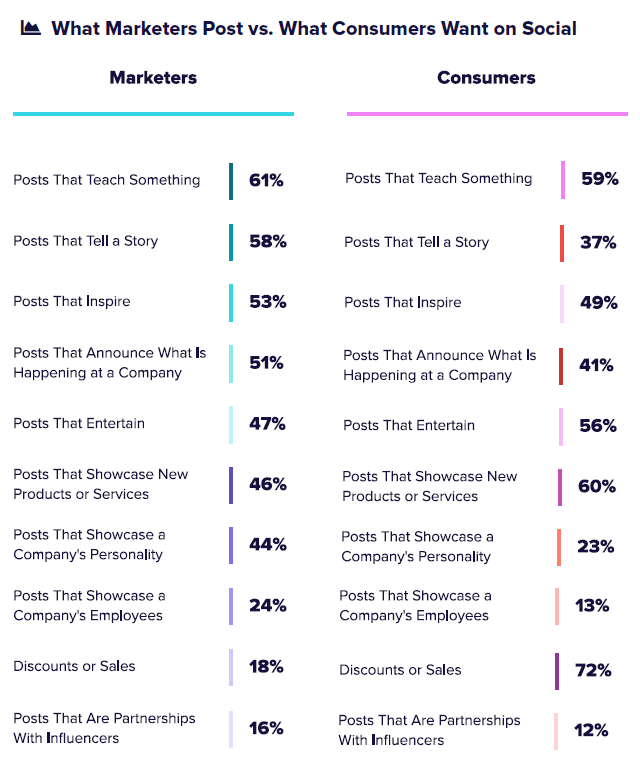Social media marketing has long become standard practice for CMOs, but are their teams focusing on the right content?
The Sprout Social 2018 Index report, released July 3 by the Chicago-based social media management software developer, aimed to find out. Its conclusion? That what marketers post on social media is frequently out of sync with what consumers are looking for.
The numbers speak for themselves (note that the original chart listed both columns in descending order, and can be viewed here):

While social media posts that teach something and posts that inspire are more or less equally demanded and provided (and neither side appears to be in a hurry to produce or read posts that are partnerships with influencers), among the other seven topics surveyed there is a gap between supply and demand of at least 10 per cent.
In the report, Sprout Social’s experts place the blame for this gap on the business world’s relentless pursuit of return on investment (ROI) in the form of sales, which they argue has a negative effect on marketers, whose first priority should be creating strong customer/client relationships.
Attributing ROI to sales “doesn’t actually reflect where social marketers are focused,” the researchers write. “Eighty per cent of social marketers say increasing brand awareness is their primary goal on social, and 80 per cent say their key strategy is increasing engagement across their social channels. In fact, only 14 per cent of marketers say they are able to quantify the revenue from social. Looking at social primarily through the sales lens breeds an overly microscopic perspective.
“That’s not because social marketers aren’t sophisticated enough to focus on conversions,” the researchers continue. “It’s because social’s true value isn’t in direct attribution—it’s in the awareness and consideration stages… It’s in expanding the net of people who know about your brand and offerings, and then nudging them… with quality content and customer service.”
If CMOs want their social media marketing teams to run truly effective campaigns, the authors write, they need to redefine ROI from the top as building consumer awareness – for example, by creating content that educates consumers about your company and the space it operates in, whether it’s through products, actions (such as travelling), or information (such as instructions or recipes).
They also note that while everyone loves a deal, social marketers can’t build strategies solely around deals and promotions, since while it leads to conversions, it’s ultimately ineffective at building long-term relationships with consumers.
Other highlights from the report include:
Consumers want brand awareness and consideration-stage content from brands on social (below), the researchers write. But 80 per cent of social media marketers focus on awareness activities, ignoring consideration entirely.

The social marketer’s number one challenge (below) is ROI, with 55 per cent of social media marketers surveyed reporting it as their top concern.
“This makes sense for two reasons,” the researchers write. “They aren’t meeting the full needs of their social audience with both brand awareness and consideration content, and they’re defining ROI incorrectly to begin with.”

Also worth noting: Facebook is the dominant force in social media marketing, with a whopping 97 per cent of respondents listing Facebook as their most used and useful social network, followed by Facebook-owned Instagram at 83 per cent. Only 13 per cent of respondents used Snapchat, even though among the general public 51 per cent of consumers use Instagram and 30 per cent use Snapchat.
To produce the report, Sprout Social asked more than 2,000 social media marketers across Canada and the U.S. how they approach structure, goals and content, including what their priorities were and under which circumstances they produced their best work, then cross-referenced their answers against what consumers actually want.
“Social is still very much a personal platform,” the researchers write. “People spend time on social, first and foremost, to interact with family and friends. As brands put together campaigns and messaging, they must remember that they are guests at dinner, not members of the nuclear family: their role in user feeds is delicate, valuable and should be treated with great care.”
You can read the full report here.





